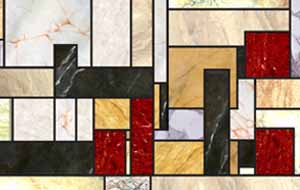Perhaps ever since the inception of conceptual art many artists have insisted on using whatever medium necessary to achieve an idea. Not willing to assign themselves to a singular medium and become hostage to history, contemporary artists often seek a variety of vehicles to accommodate their ideas. Over the years I have found myself becoming increasingly skeptical of such an ideology. Why it is appealing to think that artists have “pure” ideas and need only a vehicle to realize them, there is always the cumbersome weight of history, discipline and form that get in the way.
Armed a variety of strategies including murals, zines, posters, stickers, drawings and paintings I expected Scottish artist Lucy McKenzie to follow such an ideology. I was pleasantly surprised to find the opposite true of her current ICA show. While never allowing herself to be categorized she nevertheless addresses the very form of painting while still retaining some freedom doing it.
A pencil line wall drawing both echoes the gallery as well as creates a façade to situate the two canvases that hang prominently. The wall drawing is composed of generic columns and cornices that reference classical architecture as well as decorative murals. Curator Nicholas Baume uses the western façade of the Boston Architectural Center nearby as a point of departure. According to Baume, the mural is often employed as a means to conceal a brutalist aspect of a building, a way of “not seeing it naked.” McKenzie does not necessarily hide or put clothes on the gallery walls, for the mural is in faint pencil and only registers when closely inspected. However, this inspection makes the cornices and trim all the more intimate. In this sense, what she has added to the walls is not so much a mural, but a diagram posing as a mural.
Framed by these pencil columns are two large canvases that radiate the same type of artificiality. Made by taping out sections of the canvas and then rendering the shapes in faux marble, the paintings reference both Mondrian and fake walls. The marbleized effect of the surface is both pleasing and confounding. Faux marble is so loveably tacky. It seeks to simulate real marble though never pretends it actually is, instead, it remains content to revel in its simulation of wealth. However, real wealth always uses real marble. If faux marble is an attractive substitute for marble it makes the “real” all the more obsolete, cumbersome or expensive. This strikes me as a perfect metaphor for painting today. I find very few painters willing to spend the time to really learn the medium, instead opting for the quickest strategy to achieve easily satisfiable results. I find even more “painters” who profess to be nothing but artists who are simply making paintings. This seems to be an acceptable substitution for today’s painter. In fact, many seem to prefer this.
I should be clear that I am not arguing for a return to “real” painting, whatever that would be. Through McKenzie’s work I see the nature of painting’s affinity to representation and illusion being played out in ways that are both truthful to the state of disciplines and allows for her to be like that faux marble: once removed.
Links:
The Institute of Contemporary Art, Boston
"Momentum 2/Lucy McKenzie" is on view at the ICA 955 Boylston Street, Boston until January 2nd, 2005.
All images are courtesy of Galerie Daniel Buchholz, the ICA, and the Lucy McKenzie.
Micah J. Malone is a regular contributor to Big, Red & Shiny.




